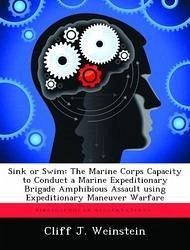
Sink or Swim
The Marine Corps Capacity to Conduct a Marine Expeditionary Brigade Amphibious Assault using Expeditionary Maneuver Warfare
Versandkostenfrei!
Versandfertig in über 4 Wochen
52,99 €
inkl. MwSt.
Weitere Ausgaben:

PAYBACK Punkte
26 °P sammeln!
Since 1991, there has been a significant drop in the number of amphibious ships, a change in the forcible entry concept and a singular military and fiscal focus on the land wars in Iraq and Afghanistan. The current state of amphibious assault ships, surface assault vehicles and assault support aircraft has suffered because of these events. Today, the readiness and capacity of the Navy and Marine Corps to plan and execute an amphibious landing on a beach against a prepared and modern enemy using modern doctrinal concepts is questionable. Can the Marine Corps conduct a Marine expeditionary briga...
Since 1991, there has been a significant drop in the number of amphibious ships, a change in the forcible entry concept and a singular military and fiscal focus on the land wars in Iraq and Afghanistan. The current state of amphibious assault ships, surface assault vehicles and assault support aircraft has suffered because of these events. Today, the readiness and capacity of the Navy and Marine Corps to plan and execute an amphibious landing on a beach against a prepared and modern enemy using modern doctrinal concepts is questionable. Can the Marine Corps conduct a Marine expeditionary brigade or MEB amphibious assault using Expeditionary Maneuver Warfare? This study addresses the equipment issues surrounding the expeditionary brigade's ability to conduct an amphibious assault under expeditionary maneuver warfare in three sections. The first section of the paper provides a background as to why the United States requires a strategic amphibious capability requirement today and its relevance against the projected future threat. The second section of paper uses the criteria of sufficiency and capability to examine the effect of equipment on the Navy and Marine Corps ability to conduct an amphibious assault using both the traditional and the contemporary Expeditionary Maneuver Warfare doctrinal concepts. The examination focuses on amphibious assault ships, AAV7A1 amphibious assault vehicles, expeditionary fighting vehicles (EFV), Sea Knight helicopter, and Osprey tiltrotor aircraft. The third section of the paper presents the conclusion that the Marine Corps can conduct a Marine expeditionary brigade amphibious assault, but not using Expeditionary Maneuver Warfare. Due to the current military situation in the world and the focus of the Marine Corps on the war in Iraq and Afghanistan, the Marine Corps cannot conduct a Marine expeditionary brigade amphibious assault using the Expeditionary Maneuver Warfare. This is due to shortfalls in the quantity, availability and cap












